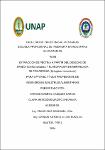| dc.contributor.advisor | Díaz Sangama, Emilio | |
| dc.contributor.advisor | Li Loo Kung, Carlos Antonio | |
| dc.contributor.author | Vasquez Garcia, Marcos Gabriel | |
| dc.contributor.author | Magipo Shapiama, Clara Mercedes | |
| dc.date.accessioned | 2025-05-12T14:57:22Z | |
| dc.date.available | 2025-05-12T14:57:22Z | |
| dc.date.issued | 2024 | |
| dc.identifier.other | X | |
| dc.identifier.uri | https://hdl.handle.net/20.500.12737/11343 | |
| dc.description.abstract | The Peruvian Amazon is diverse due to the large number of tropical fruits such as the regional watermelon and the pomarrosa, being the objective of the study to obtain and extract pectin with all its parameters: temperature, time, pH, and yield and its use in the production of jam, for the extraction of pectin hydrochloric acid was used as a reagent. at 1 N, exactly 20 drops at pH: 1.00, treatment time of 60 minutes and a temperature of 95oC, for the separation/precipitation of pectin, 96% ethanol was used, obtaining yield results of 0.14%, compared to 5,560 kg, of watermelon rind, having a humidity; 4.22%, ash: 2.67%, free acid (meq. free carbonates), methoxyl content: 2.50% expressed in galacturonic acid), being in product classified as acid pectin with low methoxyl content, the second part of the research consisted of obtaining a jam using that pectin obtained, for which the following flow was followed: raw material, reception, weighing, selection, classification, washing, blanching, pulping/refining, formulation mixing, heat treatment, pectin addition, packaging, cooling, storage and final product, for which a sensory evaluation of the five proposed formulations was carried out, concluding that the fifth is the one that meets the requirements of the NTP 203.047 Standard. In 2017, both in the physical, chemical, microbiological and the important sensory analysis, color, odor, taste and general appearance were evaluated by 25 trained panelists, statistically there is no significant difference. | en_US |
| dc.description.abstract | La Amazonia Peruana es diversa por la gran cantidad de frutas tropicales como son la sandía regional y la pomarrosa, siendo el objetivo del estudio obtener y extraer pectina con todos sus parámetros: temperatura, tiempo, pH, rendimiento y su uso en la elaboración de mermelada, para la extracción de la pectina se usó como reactivo el Ácido clorhídrico, al 1 N, exactamente 20 gotas a un pH: 1.00, tiempo de tratamiento de 60 minutos y una temperatura de 95oC, la separación/precipitación del producto pectinico se usó etanol al 96%, obteniendo resultados de rendimiento de 0.14%, con respecto a 5.560 kg, de cáscara de sandía, teniendo una humedad; 4.22%, cenizas: 2.67%, acides libre (meq. carbonatos libres), contenido de metoxilo: 2.50 % expresado en ácido galacturónico), siendo en producto clasificado como pectina ácida de bajo contenido de metoxilo, la segunda parte de la investigación constó de obtención de una mermelada usando esa pectina obtenida, para la cual se siguió el siguiente flujo: sandía fresca, recepción, peso, elección, codificación, ablución, escaldado, pulpeado/refinado, mezclado de formulación, tratamiento térmico, adición de pectina, envasado, enfriado, almacenado y producto final, para lo cual se realizó una evaluación sensorial de varias (5) formulaciones propuestas, concluyendo que la quinta es la que cumple las exigencias de la Norma NTP 203.047. 2017, tanto en la exigencia físicos químicos, microbiológicos y lo importante el análisis sensorial, se evaluó color, olor, sabor y apariencia general por 25 panelistas entrenados, estadísticamente no existe una diferencia significativa. | es_PE |
| dc.format | application/pdf | es_PE |
| dc.language.iso | spa | es_PE |
| dc.publisher | Universidad Nacional de la Amazonía Peruana | es_PE |
| dc.rights | info:eu-repo/semantics/openAccess | * |
| dc.rights.uri | https://creativecommons.org/licenses/by/4.0/ | * |
| dc.subject | X | es_PE |
| dc.subject | X | es_PE |
| dc.subject | X | es_PE |
| dc.subject | X | es_PE |
| dc.title | Extracción de pectina a partir del desecho de sandía (Citrillus lanatus); y elaboración de mermelada de pomarrosa (Syzygium malaccense) | es_PE |
| dc.type | info:eu-repo/semantics/bachelorThesis | es_PE |
| thesis.degree.discipline | Ingeniería en Industrias Alimentarias | es_PE |
| thesis.degree.grantor | Universidad Nacional de la Amazonía Peruana. Facultad de Industrias Alimentarias | es_PE |
| thesis.degree.name | Ingeniero(a) en Industrias Alimentarias | es_PE |
| dc.subject.ocde | https://purl.org/pe-repo/ocde/ford#2.11.01 | es_PE |
| renati.author.dni | 71662402 | |
| renati.author.dni | 73754438 | |
| renati.advisor.orcid | https://orcid.org/0000-0002-5424-0937 | |
| renati.advisor.orcid | https://orcid.org/0000-0002-8246-5172 | |
| renati.advisor.dni | 05222152 | |
| renati.advisor.dni | 05414897 | |
| renati.type | https://purl.org/pe-repo/renati/type#tesis | es_PE |
| renati.discipline | 721046 | es_PE |
| renati.level | https://purl.org/pe-repo/renati/level#tituloProfesional | es_PE |
| renati.juror | Barrera Meza, Elmer Alberto | |
| renati.juror | Prado Mendoza, Wilder | |
| renati.juror | Rios Cachique, Alfonso Miguel | |
| dc.publisher.country | PE | es_PE |





